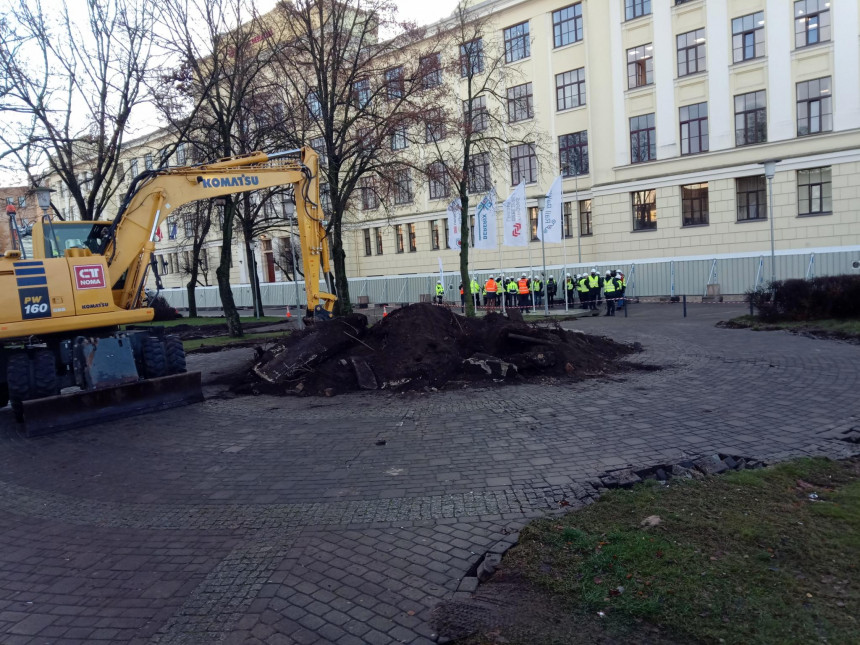Rail Baltica. Finally we are also starting to build it

Latvia, as the last participant in the Rail Baltica railway project, has started construction work. Yesterday, the flags of general contractors and contracting entity were hoisted on the masts of the construction site. In a small group, bosses addressed each other. Meanwhile, in the background, an excavator was angrily digging something in the bed at the entrance to the station.
In the Latvian section, Rail Baltica works have begun with the central railway station, the excavation of the embankment and a new bridge over Daugava. Even if, due to some global crisis, the rails from these objects will not lead to Western Europe in the future, they will in themselves improve life in Riga. Just as the new railway station at the Riga Airport. It, too, has already been designed, all the necessary permits have been received - a total of 32 -, and the builder's selection is currently continuing - eight candidates are participating in the second round of the international competition. The contracting entity hopes that at the end of the year they will be able to sign a contract with the winner and next year construction works will start there as well. In the project vision, a shuttle train will connect the airport and the central station in Riga. It travels back and forth at thirty minute intervals and will take passengers from the airport to the center of the capital in 10 minutes. They will arrive under beautiful airy canopies over the new railway bridge across Daugava. And afterwards arrivals will be able to go to the city or get on domestic, intercity or international routes.
Trees on the ground
It is planned that the Rail Baltica line will provide a fast railway connection between the capitals of the Baltic States every two hours. At the moment, in the conditions of covid, it is especially difficult to imagine why people should wander around the world so much. Riga has become so empty and quiet that visions of grandiose congestion caused by construction of this scale may have to be reconsidered. For the time being, the construction site is located only behind the central station - near the Ministry of Transport and the administrative building of Latvijas Dzelzceļš - and disturbs traffic only for civil servants. They will be the first to change their travel habits, because there is no longer a place to park their cars at work. As is usually the case, the first job on the site was to cut down trees. They grew along the railway embankment - closer to Dzirnavu Street. Further works are site release and preparation, dismantling buildings, relocation of railway infrastructure. Major construction will begin in the spring.
Everyone can monitor through the fence
It should be recalled that the construction work at this junction is carried out by BERERIX, which consists of the largest construction company in Belgium, the BESIX Group, the local construction company RERE Būve and the Italian company Rizzani de Eccher, and is supervised by civil engineers from Egis-Deutche Bahn.
Those interested can already follow the activity of the builders now, because viewing holes have been installed in the fence of the construction site. Of course, the work of builders is also affected by the pandemic. That is why the opening event was so modest. A small group of bosses and an excavator in the background. The most important thing is to protect the builders from the virus. Therefore, a special schedule has been introduced on the construction site on how to arrive at the site to avoid congestion. The work is organized in teams of 12 people, which do not change, so that if necessary, those affected by the virus can be placed in isolation, but the work as a whole does not have to be interrupted. There has also been training to work in a pandemic situation, and a special covid guard is constantly on site. Basically, he is the epidemiologist of the facility.
Money is on its way
Watching the trees creak as they fall on the ground, old ladies grumbled yesterday that soon there would be nothing to breathe in Riga, but a couple of early drinkers approvingly discussed that they could finally go to Berlin by high-speed train.
According to the project schedule, that should take place in 2026. Thus, the transformations of the center of Riga caused by the project must take place by then. In the vision for the future, in place of the embankment there will be tracks raised on the trestle, and a covered public outdoor space below. It can only be hoped that it will not become similar to the covered outdoor space in tunnels under the station forecourt. Currently, the view there is terrible, but to move through there, especially in the late hours of the day, is dangerous to health. In visualizations, with the arrival of Rail Baltica, the urban environment of Riga also becomes bright and pleasant. You can see them here.
The project promoters have just received good news, so far unofficially. Another tranche of money from the European Commission is on its way. The sixth call of the Connecting Europe Facility (CEF6) has been signed.
Cleaning up the part of Riga around the station, of course, is not part of the project. It will have to be dealt with by the municipality, and the money will also have to be provided for this purpose. But Rail Baltica will be the catalyst for the city's development. All that remains is to use it.
